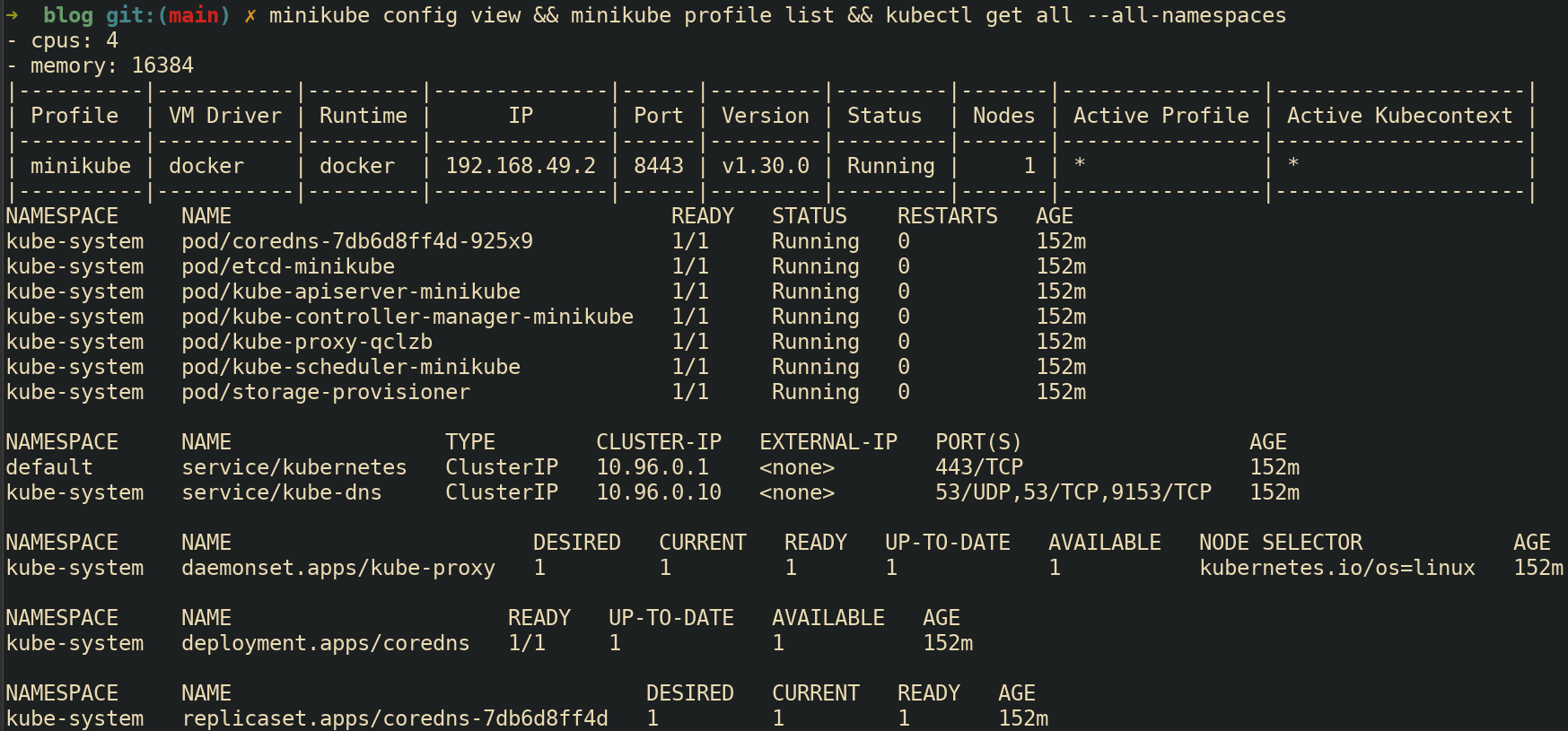Kubernetes Privileged Containers and Namespaces
Recently, I was investigating the Linux namespace isolation between privileged pods and learned an interesting fact of how Kubernetes treats privileged pods at the Linux namespace level.
The following post is notes from a full day of trying to answer the question: What are the differences in isolation and capabilities between a privileged pod and a non-privileged pod with specific host namespace sharing configurations in Kubernetes?
TLDR;
Marking a pod as privileged: true does
not instruct Kubernetes to place the Pod’s container
into the same namespaces as the host. A privileged pod still has most of
its namespaces isolated from the host, except for the user namespace
(which I hope to touch on in a later post)
However, setting specific pod specs such as
hostNetwork: true, hostPID: true, and
hostIPC: true causes the pod to share those specific
namespaces (network, net (and
uts), ipcrespectively) with the host.
What setting privileged: true is doing at the system
level is allocating the Pod’s containers a broad set of Linux
capabilities, allowing it to perform privileged system operations, but
it does not technically share the namespaces like
hostNetwork/hostPID/hostIPC.
Privileged Pod Investigation
Consider the following Pod manifest that’s only noteworthy field is
the privileged: true field.
apiVersion: v1
kind: Pod
metadata:
name: privileged-only
spec:
containers:
- name: busybox
image: busybox
command: ["sleep", "3600"]
securityContext:
privileged: trueOften, privileged pods are described as “dissolving all isolation between the pod and the node” or “Processes within the container get almost the same privileges that are available to processes outside a container” - KubeSec.io
This is common over simplification. While typically getting the point of “don’t use privileged pods wherever possible” across, sometimes digging into these areas can lead to interesting insights into how technology works.
The (not entirely correct) assumption that I made was that marking a
pod as privileged: true, simply instruct Kubernetes (Or
really the Container Runtime Interface) to skip creating a new namespace
for the pod. Reasonable assumption? I think so, which is why I was
somewhat surprised when I noticed that when running the above Pod
manifest, the only namespace the Pod shared with the host was the user
namespace.
# Namespace: The linux namespace
# HOST-ID: The namespace ID of the host.
# CONTAINER-ID: The namespace ID of the container
# NS-STATUS: ISOLATED == Pod's container is in it's own namespace
# SHARED == Pod's container shares the host's namespace
NAMESPACE HOST-ID CONTAINER-ID NS-STATUS
cgroup 4026534899 4026535998 ISOLATED
ipc 4026534893 4026535503 ISOLATED
mnt 4026534836 4026535995 ISOLATED
net 4026534900 4026535505 ISOLATED
pid 4026534898 4026535997 ISOLATED
user 4026531837 4026531837 SHARED
uts 4026534891 4026535996 ISOLATEDA quick aside about the HOST-IDs and
CONTAINER-IDs. These numbers are the inode numbers that
identify each namespace in the kernel.
- When two processes have the same inode number for a particular namespace, it means they share that namespace.
- When they have different inode numbers, they’re “isolated” from each other by being in different namespaces.
I wanted to do some testing to figure out what exactly was going on.
If a privileged Pod’s container isn’t sharing namespaces with the
host, does setting any of those namespaces manually in the Pod manifest
also behave that way? For example, does hostNetwork: true
in the following manifest share the net namespace with the
host??
# Example
apiVersion: v1
kind: Pod
metadata:
name: network-shared
spec:
hostNetwork: true
containers:
- name: busybox
image: busybox
command: ["sleep", "3600"]A helping hand
We could test this by manually writing Pod manifests with our desired specifications, but it’s painful, time-consuming, and error prone. The following script allows us to check each individual Pod spec that controls these namespaces.
#!/bin/bash
# Default flag values
DO_PID=false
DO_NETWORK=false
DO_IPC=false
# Parse command line arguments
while [[ $# -gt 0 ]]; do
key="$1"
case $key in
--pid)
DO_PID=true
shift
;;
--hostnetwork)
DO_NETWORK=true
shift
;;
--ipc)
DO_IPC=true
shift
;;
--help)
echo "Usage: $0 [--pid] [--hostnetwork] [--ipc]"
echo "Specify which namespace sharing options to test"
exit 0
;;
*)
echo "Unknown option: $1"
echo "Usage: $0 [--pid] [--hostnetwork] [--ipc]"
exit 1
;;
esac
done
# If no flags specified, show usage
if ! $DO_PID && ! $DO_NETWORK && ! $DO_IPC; then
echo "Usage: $0 [--pid] [--hostnetwork] [--ipc]"
echo "At least one option must be specified"
exit 1
fi
# Start minikube if not running
minikube status &> /dev/null || minikube start
# Wait for default service account
while ! kubectl get serviceaccount default &> /dev/null; do
sleep 2
done
# Function to check pod namespaces
check_pod() {
NAME=$1
echo "POD: $NAME"
# Wait for pod to be ready
while [ "$(kubectl get pod $NAME -o 'jsonpath={.status.phase}' 2>/dev/null)" != "Running" ]; do
sleep 2
done
# Get container ID
CONTAINER_ID=$(kubectl get pod $NAME -o 'jsonpath={.status.containerStatuses[0].containerID}' | sed 's/docker:\/\///')
# Check namespaces
minikube ssh "
CONTAINER_PID=\$(sudo docker inspect --format='{{.State.Pid}}' $CONTAINER_ID)
echo 'NAMESPACE HOST-ID CONTAINER-ID NS-STATUS'
for NS in cgroup ipc mnt net pid user uts; do
HOST_NS=\$(sudo readlink /proc/1/ns/\$NS)
CONTAINER_NS=\$(sudo readlink /proc/\$CONTAINER_PID/ns/\$NS)
HOST_ID=\$(echo \$HOST_NS | sed 's/.*\\[\\(.*\\)\\]/\\1/')
CONTAINER_ID=\$(echo \$CONTAINER_NS | sed 's/.*\\[\\(.*\\)\\]/\\1/')
SHARED=\$([ \"\$HOST_NS\" = \"\$CONTAINER_NS\" ] && echo 'SHARED' || echo 'ISOLATED')
printf \"%-10s %-25s %-24s %s\\n\" \"\$NS\" \"\$HOST_ID\" \"\$CONTAINER_ID\" \"\$SHARED\"
done
"
echo ""
}
# Create shared network pod if requested
if $DO_NETWORK; then
echo "=== hostNetwork ==="
POD1=$(cat <<EOF
apiVersion: v1
kind: Pod
metadata:
name: network-shared
spec:
hostNetwork: true
containers:
- name: busybox
image: busybox
command: ["sleep", "3600"]
EOF
)
echo "$POD1"
echo "$POD1" | kubectl apply -f -
check_pod "network-shared"
kubectl delete pod network-shared --force &> /dev/null
fi
# Create shared PID pod if requested
if $DO_PID; then
echo "=== hostPID ==="
POD2=$(cat <<EOF
apiVersion: v1
kind: Pod
metadata:
name: pid-shared
spec:
hostPID: true
containers:
- name: busybox
image: busybox
command: ["sleep", "3600"]
EOF
)
echo "$POD2"
echo "$POD2" | kubectl apply -f -
check_pod "pid-shared"
kubectl delete pod pid-shared --force &> /dev/null
fi
# Create shared IPC pod if requested
if $DO_IPC; then
echo "=== hostIPC ==="
POD3=$(cat <<EOF
apiVersion: v1
kind: Pod
metadata:
name: ipc-shared
spec:
hostIPC: true
containers:
- name: busybox
image: busybox
command: ["sleep", "3600"]
EOF
)
echo "$POD3"
echo "$POD3" | kubectl apply -f -
check_pod "ipc-shared"
kubectl delete pod ipc-shared --force &> /dev/null
fiRunning ./checkNS.sh --ipc --pid --hostnetwork yields
tests each of the big three pod specifications I’m interested in. The
results are shown below.
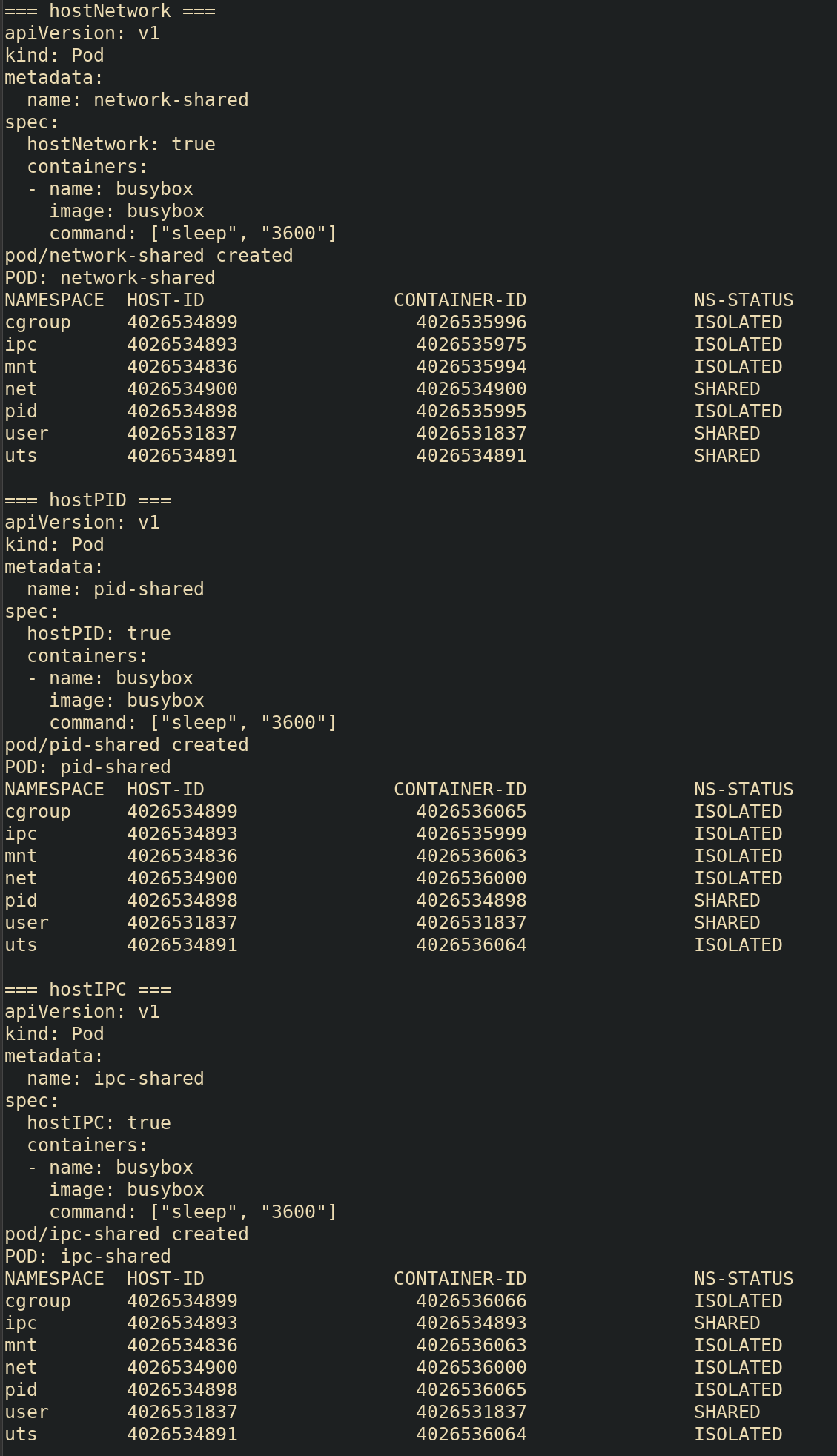
Lets dig in to each of these
hostNetwork
The Pod being applied is only setting
hostNetwork: true.
apiVersion: v1
kind: Pod
metadata:
name: shared
spec:
hostNetwork: true # Here
containers:
- name: busybox
image: busybox
command: ["sleep", "3600"]Interestingly, the net, uts, and
user namespaces are now being shared between the host and
the container. The net namespace makes sense as we
explicitly set hostNetwork: true.
The interesting observation is that setting
hostNetwork: true also shares uts namespace
between the container and the host. I’m not 100% sure why this is, but
it makes sense as the uts namespace is used for setting the
hostname/domain name.
NAMESPACE HOST-ID CONTAINER-ID NS-STATUS
cgroup 4026534899 4026536006 ISOLATED
ipc 4026534893 4026536001 ISOLATED
mnt 4026534836 4026536004 ISOLATED
net 4026534900 4026534900 SHARED
pid 4026534898 4026536005 ISOLATED
user 4026531837 4026531837 SHARED
uts 4026534891 4026534891 SHAREDhostNetwork demonstration
Exec-ing into the Pod’s container allows for inspection of resources
in the hosts network namespace from inside the container by running
ss -tuln | grep LISTEN on both the host and inside the
Pod’s container.
#!/bin/bash
# Start minikube if not running
minikube status &> /dev/null || minikube start
# Silently install iproute2 on minikube node if ss is not available
minikube ssh "command -v ss >/dev/null 2>&1 || { sudo apt-get update -qq && sudo apt-get install -qq iproute2 >/dev/null; }"
# Create hostNetwork pod with a network tools image instead of busybox
echo "=== Creating pod with hostNetwork ==="
cat <<EOF | kubectl apply -f -
apiVersion: v1
kind: Pod
metadata:
name: network-shared
spec:
hostNetwork: true
containers:
- name: network-test
image: nicolaka/netshoot # Note we changed the image
command: ["sleep", "3600"]
EOF
# Wait for pod to be ready
echo "Waiting for pod to be running..."
while [ "$(kubectl get pod network-shared -o 'jsonpath={.status.phase}' 2>/dev/null)" != "Running" ]; do
sleep 2
done
# Check namespace to confirm network is shared
CONTAINER_ID=$(kubectl get pod network-shared -o 'jsonpath={.status.containerStatuses[0].containerID}' | sed 's/docker:\/\///')
minikube ssh "
CONTAINER_PID=\$(sudo docker inspect --format='{{.State.Pid}}' $CONTAINER_ID)
echo 'NAMESPACE HOST-ID CONTAINER-ID NS-STATUS'
HOST_NS=\$(sudo readlink /proc/1/ns/net)
CONTAINER_NS=\$(sudo readlink /proc/\$CONTAINER_PID/ns/net)
HOST_ID=\$(echo \$HOST_NS | sed 's/.*\\[\\(.*\\)\\]/\\1/')
CONTAINER_ID=\$(echo \$CONTAINER_NS | sed 's/.*\\[\\(.*\\)\\]/\\1/')
SHARED=\$([ \"\$HOST_NS\" = \"\$CONTAINER_NS\" ] && echo 'SHARED' || echo 'ISOLATED')
printf \"%-10s %-25s %-24s %s\\n\" \"net\" \"\$HOST_ID\" \"\$CONTAINER_ID\" \"\$SHARED\"
"
# Compare listening ports using ss
echo -e "\n=== Ports listening on host ==="
minikube ssh "ss -tuln | grep LISTEN"
echo -e "\n=== Ports visible from container ==="
kubectl exec -it network-shared -- ss -tuln | grep LISTEN
# Clean up
echo -e "\n=== Cleaning up ==="
kubectl delete pod network-shared --force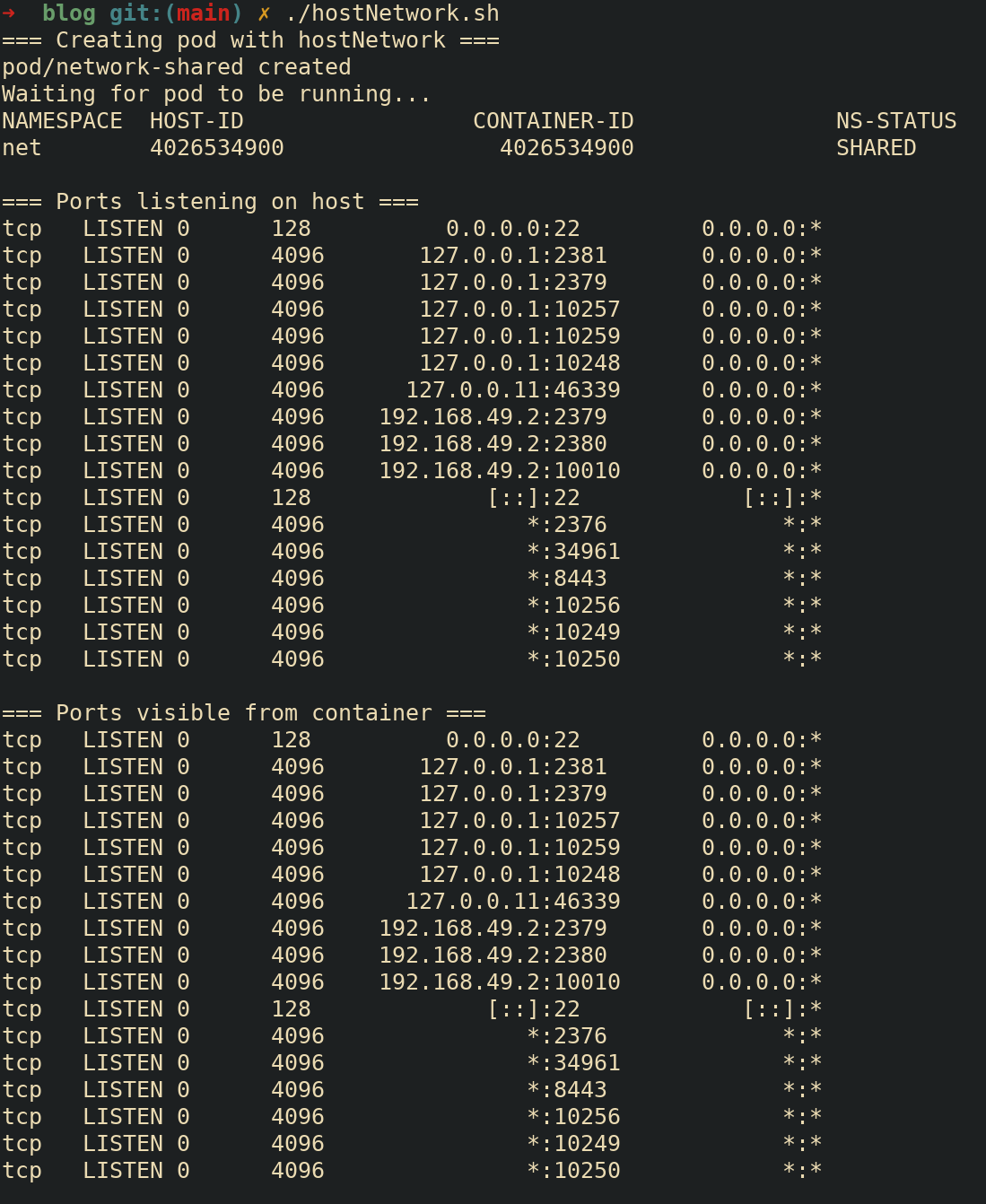
hostPID
The next pod being applied is only setting
hostPID: true.
apiVersion: v1
kind: Pod
metadata:
name: shared
spec:
hostPID: true # Here
containers:
- name: busybox
image: busybox
command: ["sleep", "3600"]Setting hostPID: true shares the pid
namespace between the host and the container, allowing for the container
to interact with processes on the host. No surprises there.
NAMESPACE HOST-ID CONTAINER-ID NS-STATUS
cgroup 4026534899 4026536126 ISOLATED
ipc 4026534893 4026536063 ISOLATED
mnt 4026534836 4026536124 ISOLATED
net 4026534900 4026536064 ISOLATED
pid 4026534898 4026534898 SHARED
user 4026531837 4026531837 SHARED
uts 4026534891 4026536125 ISOLATEDhostPID Demonstration
Exec-ing into the pod would allow us to see the host’s processes by
running ps aux. Here is a modification of our earlier
script to demonstrate that. Note the output is showing processes from
the node.
#!/bin/bash
# Start minikube if not running
minikube status &> /dev/null || minikube start
# Wait for default service account
while ! kubectl get serviceaccount default &> /dev/null; do
sleep 2
done
# Create hostPID pod
echo "=== Creating pod with hostPID ==="
POD=$(cat <<EOF
apiVersion: v1
kind: Pod
metadata:
name: pid-shared
spec:
hostPID: true
containers:
- name: busybox
image: busybox
command: ["sleep", "3600"]
EOF
)
echo "$POD" | kubectl apply -f -
# Wait for pod to be ready
echo "Waiting for pod to be running..."
while [ "$(kubectl get pod pid-shared -o 'jsonpath={.status.phase}' 2>/dev/null)" != "Running" ]; do
sleep 2
done
# Function to check pod namespaces
echo "Checking pod namespaces..."
CONTAINER_ID=$(kubectl get pod pid-shared -o 'jsonpath={.status.containerStatuses[0].containerID}' | sed 's/docker:\/\///')
# Check namespaces
minikube ssh "
CONTAINER_PID=\$(sudo docker inspect --format='{{.State.Pid}}' $CONTAINER_ID)
echo 'NAMESPACE HOST-ID CONTAINER-ID NS-STATUS'
for NS in cgroup ipc mnt net pid user uts; do
HOST_NS=\$(sudo readlink /proc/1/ns/\$NS)
CONTAINER_NS=\$(sudo readlink /proc/\$CONTAINER_PID/ns/\$NS)
HOST_ID=\$(echo \$HOST_NS | sed 's/.*\\[\\(.*\\)\\]/\\1/')
CONTAINER_ID=\$(echo \$CONTAINER_NS | sed 's/.*\\[\\(.*\\)\\]/\\1/')
SHARED=\$([ \"\$HOST_NS\" = \"\$CONTAINER_NS\" ] && echo 'SHARED' || echo 'ISOLATED')
printf \"%-10s %-25s %-24s %s\\n\" \"\$NS\" \"\$HOST_ID\" \"\$CONTAINER_ID\" \"\$SHARED\"
done
"
# Execute into the pod and run ps aux
echo -e "\n=== Executing into pod to run ps aux ==="
kubectl exec -it pid-shared -- ps aux
# Clean up
echo -e "\n=== Cleaning up ==="
kubectl delete pod pid-shared --force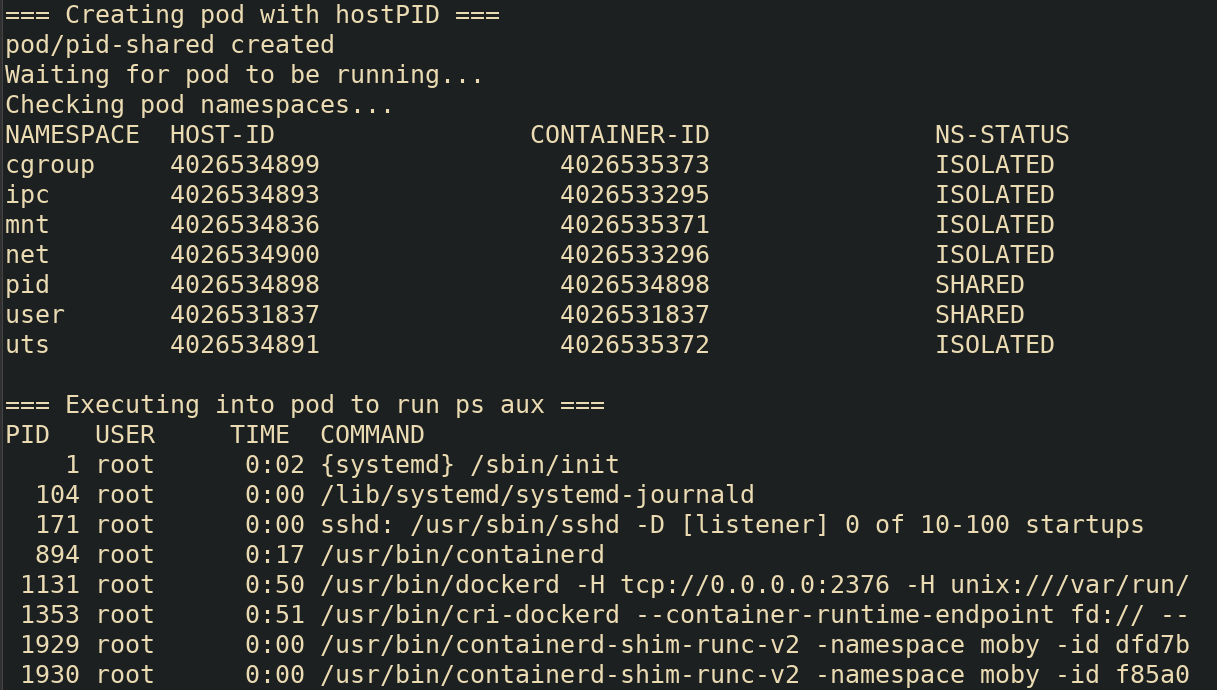
hostIPC
The next pod being applied is only setting
hostIPC: true.
apiVersion: v1
kind: Pod
metadata:
name: shared
spec:
hostIPC: true
containers:
- name: busybox
image: busybox
command: ["sleep", "3600"]Setting the hostIPC: true allows the pods to share the
ipc namespace which allows containers to do various
shenanigans such as accessing the hosts shared memory segments,
interfere with semaphores and message queues, etc. Again, no surprises
here, we see the ipc namespace is now shared
NAMESPACE HOST-ID CONTAINER-ID NS-STATUS
cgroup 4026534899 4026536127 ISOLATED
ipc 4026534893 4026534893 SHARED
mnt 4026534836 4026536124 ISOLATED
net 4026534900 4026536064 ISOLATED
pid 4026534898 4026536126 ISOLATED
user 4026531837 4026531837 SHARED
uts 4026534891 4026536125 ISOLATEDIPC Demonstration
Exec-ing into the pod allows for inspection of the hosts
ipc is visible inside the container by running
sudo ipcs -q. They’re the same, demonstrating the shared
namespace. You
can read more about message queues here.
#!/bin/bash
# Start minikube if not running
minikube status &> /dev/null || minikube start
# Create hostIPC pod
echo "=== Creating pod with hostIPC ==="
cat <<EOF | kubectl apply -f -
apiVersion: v1
kind: Pod
metadata:
name: ipc-shared
spec:
# hostIPC: true
containers:
- name: ipc-test
image: busybox
command: ["sleep", "3600"]
EOF
# Wait for pod to be ready
echo "Waiting for pod to be running..."
while [ "$(kubectl get pod ipc-shared -o 'jsonpath={.status.phase}' 2>/dev/null)" != "Running" ]; do
sleep 2
done
# Show only message queues on host
echo -e "\n=== Message Queues visible on host ==="
minikube ssh "sudo ipcs -q"
# Show only message queues in container
echo -e "\n=== Message Queues visible in container ==="
kubectl exec -it ipc-shared -- ipcs -q
# Clean up
echo -e "\n=== Cleaning up ==="
kubectl delete pod ipc-shared --force
Privileged vs All Specs
Now that we’ve tested the big three pod specs, lets compare our original privileged Pod to our Pod manifest where we explicitly set the spec to share certain namespaces.
=== PRIVILEGED ONLY ===
apiVersion: v1
kind: Pod
metadata:
name: privileged-only
spec:
containers:
- name: busybox
image: busybox
command: ["sleep", "3600"]
securityContext:
privileged: true
NAMESPACE HOST-ID CONTAINER-ID STATUS
cgroup 4026534899 4026536059 ISOLATED
ipc 4026534893 4026535975 ISOLATED
mnt 4026534836 4026536056 ISOLATED
net 4026534900 4026535982 ISOLATED
pid 4026534898 4026536058 ISOLATED
user 4026531837 4026531837 SHARED
uts 4026534891 4026536057 ISOLATED
=== SHARED NAMESPACES ===
apiVersion: v1
kind: Pod
metadata:
name: shared
spec:
hostNetwork: true
hostPID: true
hostIPC: true
containers:
- name: busybox
image: busybox
command: ["sleep", "3600"]
NAMESPACE HOST-ID CONTAINER-ID STATUS
cgroup 4026534899 4026536064 ISOLATED
ipc 4026534893 4026534893 SHARED
mnt 4026534836 4026536063 ISOLATED
net 4026534900 4026534900 SHARED
pid 4026534898 4026534898 SHARED
user 4026531837 4026531837 SHARED
uts 4026534891 4026534891 SHAREDWe have verified that explicitly setting pod specifications that
allow sharing of the host namespace
(hostNetwork: true,hostPID: true, and
hostIPC: true), indeed place the Pod’s container into the
same namespace as the host and that running a pod as Privileged does
not place a Pod’s container in the same namespace as the host.
Why?
Digging deeper through the Kubernetes documentation gave some subtle hints as to what is actually going on
“Any container in a Pod can enable Privileged mode if you set the
privileged: truefield in thesecurityContextfield for the container. Privileged containers override or undo many other hardening settings such as the applied seccomp profile, AppArmor profile, or SELinux constraints. Privileged containers are given all Linux capabilities, including capabilities that they don’t require. For example, a root user in a privileged container might be able to use theCAP_SYS_ADMINandCAP_NET_ADMINcapabilities on the node, bypassing the runtime seccomp configuration and other restrictions.” - Kubernetes Documentation
How are pods marked as Privileged able to access resources on the host if they’re “isolated” in their own namespaces?
Capabilities
It turns out, the answer is: capabilities.
While this post isn’t a deep dive into Linux capabilities, it might be helpful to briefly recap what capabilities are in Linux.
Capabilities are gradual “permissions” that can be assigned to programs that allow very specific privileges that are otherwise reserved for the root user. This is great from the principal of least privilege perspective as it reduces the attack surface if an attacker is able to tamper with a program.
In a world without capabilities, if a user wanted to run a webserver on port 80, that process would have to be run as root because binding to ports under 1024 is a “privileged” action that must be done by root.
With the CAP_NET_BIND_SERVICE capability, the user can
take that one very specific “rootly” power of binding to a privileged
port and give it to that program instead of running that webserver as
root using the
sudo setcap cap_net_bind_service=+ep webserver_program
command
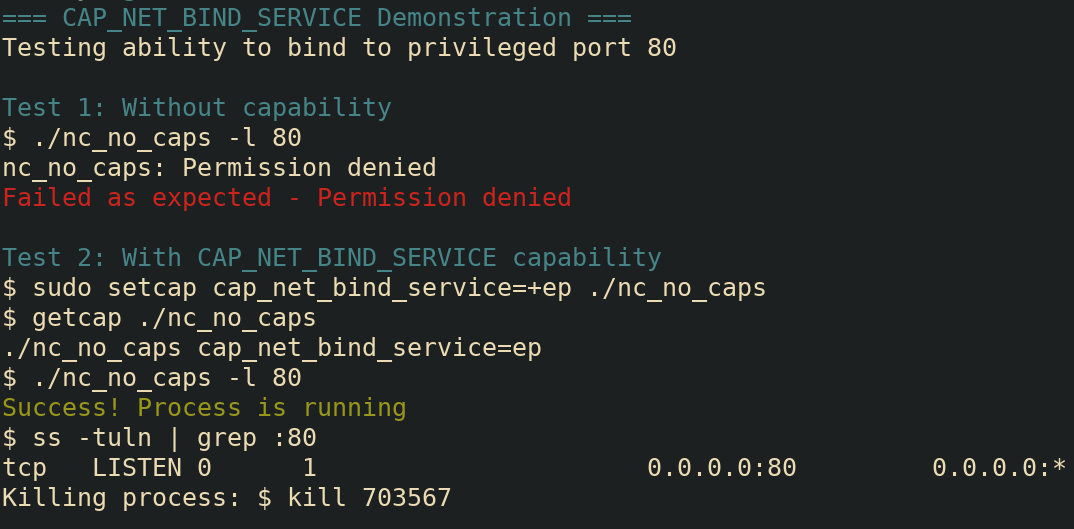
#!/bin/bash
# Set text colors
RED='\033[0;31m'
GREEN='\033[0;32m'
BLUE='\033[0;34m'
NC='\033[0m' # No Color
echo -e "${BLUE}=== CAP_NET_BIND_SERVICE Demonstration ===${NC}"
echo "Testing ability to bind to privileged port 80"
# Setup
TEMP_DIR=$(mktemp -d)
cd "$TEMP_DIR"
cp $(which nc) ./nc_no_caps
# Test 1: Without capability
echo -e "\n${BLUE}Test 1: Without capability${NC}"
echo -e "$ ./nc_no_caps -l 80"
./nc_no_caps -l 80 &
PID=$!
sleep 1
if kill -0 $PID 2>/dev/null; then
echo -e "${GREEN}Unexpectedly succeeded${NC}"
kill $PID
else
echo -e "${RED}Failed as expected - Permission denied${NC}"
fi
# Test 2: With capability
echo -e "\n${BLUE}Test 2: With CAP_NET_BIND_SERVICE capability${NC}"
echo -e "$ sudo setcap cap_net_bind_service=+ep ./nc_no_caps"
sudo setcap cap_net_bind_service=+ep ./nc_no_caps
echo -e "$ getcap ./nc_no_caps"
getcap ./nc_no_caps
echo -e "$ ./nc_no_caps -l 80"
./nc_no_caps -l 80 &
PID=$!
sleep 1
if kill -0 $PID 2>/dev/null; then
echo -e "${GREEN}Success! Process is running${NC}"
# Verify binding
echo -e "$ ss -tuln | grep :80"
ss -tuln | grep :80
echo -e "Killing process: $ kill $PID"
kill $PID
else
echo -e "${RED}Failed to run - port 80 may already be in use${NC}"
fi
# Clean up
echo -e "\n${BLUE}Cleaning up${NC}"
echo -e "$ cd ~"
cd ~
echo -e "$ rm -rf $TEMP_DIR"
rm -rf "$TEMP_DIR"
echo -e "\n${GREEN}Demonstration complete!${NC}"Getting a list of capabilities can be done by running
grep -E '^#define CAP_' /usr/include/linux/capability.h.
Currently there are ~40.
The end of the rabbithole
Now that we have briefly touched on Linux capabilities, lets see how they’re used to answer the question: How are pods marked as Privileged able to access resources on the host if they’re “isolated” in their own namespaces?
The key is that there are two separate mechanisms at work:
- Namespace sharing (
hostNetwork,hostPID,hostIPC) - These settings determine which namespaces a pod shares with the host, providing specific types of access. - Linux capabilities - These determine what privileged operations a container can perform, regardless of namespace isolation.
One final time, lets write a script that makes this process much easier to understand, this is a long one but essentially we want to get all the capabilities assigned to each container.
#!/bin/bash
# Define color codes
RED='\033[0;31m'
GREEN='\033[0;32m'
YELLOW='\033[0;33m'
BLUE='\033[0;34m'
PURPLE='\033[0;35m'
CYAN='\033[0;36m'
WHITE='\033[0;37m'
BOLD='\033[1m'
BG_RED='\033[41m'
BG_GREEN='\033[42m'
BG_BLUE='\033[44m'
NC='\033[0m' # No Color
# Function for colorful section headers
print_header() {
echo -e "\n${BG_BLUE}${BOLD}${WHITE} $1 ${NC}"
echo -e "${BLUE}$(printf '=%.0s' {1..70})${NC}"
}
# Function for sub-headers
print_subheader() {
echo -e "\n${BOLD}${CYAN} $1 ${NC}"
echo -e "${CYAN}$(printf '-%.0s' {1..70})${NC}"
}
# Function to show status
show_status() {
if [ "$2" == "OK" ]; then
echo -e "[$1] ${GREEN}✓ $3${NC}"
elif [ "$2" == "WARN" ]; then
echo -e "[$1] ${YELLOW}⚠ $3${NC}"
else
echo -e "[$1] ${RED}✗ $3${NC}"
fi
}
# Start minikube if not running
print_header "KUBERNETES SECURITY TEST SUITE"
echo -e "${YELLOW}Initializing test environment...${NC}"
show_status "SETUP" "WARN" "Checking if minikube is running"
if minikube status &> /dev/null; then
show_status "SETUP" "OK" "Minikube is running"
else
show_status "SETUP" "WARN" "Starting minikube"
minikube start
show_status "SETUP" "OK" "Minikube started successfully"
fi
# Wait for default service account
show_status "SETUP" "WARN" "Waiting for default service account"
while ! kubectl get serviceaccount default &> /dev/null; do
sleep 2
echo -n -e "${YELLOW}.${NC}"
done
show_status "SETUP" "OK" "Default service account is available"
# Ensure bc is installed on minikube node
show_status "SETUP" "WARN" "Checking if bc is installed in minikube"
minikube ssh "command -v bc &> /dev/null || { echo 'Installing bc...'; sudo apt-get update && sudo apt-get install -y bc; }"
show_status "SETUP" "OK" "bc is available in minikube"
# Function to check namespaces and capabilities
check_container() {
POD_NAME=$1
echo "CHECKING CONTAINER: $POD_NAME"
# Get container ID
CONTAINER_ID=$(kubectl get pod $POD_NAME -o 'jsonpath={.status.containerStatuses[0].containerID}' | sed 's/docker:\/\///')
echo -e "${BOLD}Container ID:${NC} ${YELLOW}$CONTAINER_ID${NC}"
# Check namespaces and compare with host
minikube ssh "
# Get container PID
CONTAINER_PID=\$(sudo docker inspect --format='{{.State.Pid}}' $CONTAINER_ID)
echo -e \"Container PID on host: \${CONTAINER_PID}\"
echo \"\"
# Compare namespaces
echo -e \"\033[1;36m--- Namespace Comparison ---\033[0m\"
echo -e \"\033[1mNAMESPACE HOST-ID CONTAINER-ID STATUS\033[0m\"
echo -e \"\033[36m---------- ----------------------- ------------------------ --------\033[0m\"
for NS in cgroup ipc mnt net pid user uts; do
HOST_NS=\$(sudo readlink /proc/1/ns/\$NS)
CONTAINER_NS=\$(sudo readlink /proc/\$CONTAINER_PID/ns/\$NS)
# Extract just the ID number for cleaner display
HOST_ID=\$(echo \$HOST_NS | sed 's/.*\\[\\(.*\\)\\]/\\1/')
CONTAINER_ID=\$(echo \$CONTAINER_NS | sed 's/.*\\[\\(.*\\)\\]/\\1/')
SHARED=\$([ \"\$HOST_NS\" = \"\$CONTAINER_NS\" ] && echo -e \"\033[31mSHARED\033[0m\" || echo -e \"\033[32mISOLATED\033[0m\")
printf \"%-10s %-25s %-24s %b\\n\" \"\$NS\" \"\$HOST_ID\" \"\$CONTAINER_ID\" \"\$SHARED\"
done
echo \"\"
echo -e \"\033[1;36m--- Capability Information ---\033[0m\"
echo \"Checking capabilities from /proc/\$CONTAINER_PID/status:\"
echo \"\"
echo -e \"\033[1;33m### Container Capabilities ###\033[0m\"
CONT_CAP_EFF=\$(sudo grep CapEff /proc/\$CONTAINER_PID/status | awk '{print \$2}')
CONT_CAP_PRM=\$(sudo grep CapPrm /proc/\$CONTAINER_PID/status | awk '{print \$2}')
CONT_CAP_INH=\$(sudo grep CapInh /proc/\$CONTAINER_PID/status | awk '{print \$2}')
CONT_CAP_BND=\$(sudo grep CapBnd /proc/\$CONTAINER_PID/status | awk '{print \$2}')
CONT_CAP_AMB=\$(sudo grep CapAmb /proc/\$CONTAINER_PID/status | awk '{print \$2}')
echo -e \"\033[1mCapEff (Effective): \033[0m \033[33m\$CONT_CAP_EFF\033[0m\"
echo -e \"\033[1mCapPrm (Permitted): \033[0m \033[33m\$CONT_CAP_PRM\033[0m\"
echo -e \"\033[1mCapInh (Inheritable):\033[0m \033[33m\$CONT_CAP_INH\033[0m\"
echo -e \"\033[1mCapBnd (Bounding): \033[0m \033[33m\$CONT_CAP_BND\033[0m\"
echo -e \"\033[1mCapAmb (Ambient): \033[0m \033[33m\$CONT_CAP_AMB\033[0m\"
# Save effective capabilities for summary comparison
echo \$CONT_CAP_EFF > /tmp/${POD_NAME}_capeff
# Decode effective capabilities
echo \"\"
echo -e \"\033[1;33m### Decoded Effective Capabilities ###\033[0m\"
echo \"The effective capabilities (CapEff) determine what privileged operations a process can actually perform.\"
echo \"\"
# Using bc to decode capabilities
echo \"Using bc to decode capabilities...\"
# Using a simplified list of common capabilities for demonstration
cap_map=(
\"0:CAP_CHOWN - Change file ownership and group\"
\"1:CAP_DAC_OVERRIDE - Bypass file read, write, and execute permission checks\"
\"2:CAP_DAC_READ_SEARCH - Bypass file read permission checks\"
\"3:CAP_FOWNER - Bypass permission checks on operations that normally require the file system UID to match the process's\"
\"4:CAP_FSETID - Don't clear set-user-ID and set-group-ID mode bits when a file is modified\"
\"5:CAP_KILL - Bypass permission checks for sending signals\"
\"6:CAP_SETGID - Make arbitrary manipulations of process GIDs\"
\"7:CAP_SETUID - Make arbitrary manipulations of process UIDs\"
\"8:CAP_SETPCAP - Modify process capabilities\"
\"9:CAP_LINUX_IMMUTABLE - Set the FS_APPEND_FL and FS_IMMUTABLE_FL flags\"
\"10:CAP_NET_BIND_SERVICE - Bind a socket to Internet domain privileged ports\"
\"11:CAP_NET_BROADCAST - Make socket broadcasts and listen to multicasts\"
\"12:CAP_NET_ADMIN - Perform network administration tasks\"
\"13:CAP_NET_RAW - Use raw sockets\"
\"14:CAP_IPC_LOCK - Lock memory\"
\"15:CAP_IPC_OWNER - Bypass permissions on message queues and shared memory\"
\"16:CAP_SYS_MODULE - Load and unload kernel modules\"
\"17:CAP_SYS_RAWIO - Perform I/O port operations\"
\"18:CAP_SYS_CHROOT - Use chroot()\"
\"19:CAP_SYS_PTRACE - Trace arbitrary processes\"
\"20:CAP_SYS_PACCT - Configure process accounting\"
\"21:CAP_SYS_ADMIN - Perform various system administration operations\"
\"22:CAP_SYS_BOOT - Use reboot() and kexec_load()\"
\"23:CAP_SYS_NICE - Raise process nice value and change nice value for arbitrary processes\"
\"24:CAP_SYS_RESOURCE - Override resource limits\"
\"25:CAP_SYS_TIME - Set system clock\"
\"26:CAP_SYS_TTY_CONFIG - Configure TTY devices\"
\"27:CAP_MKNOD - Create special files\"
\"28:CAP_LEASE - Establish leases on files\"
\"29:CAP_AUDIT_WRITE - Write records to kernel auditing log\"
\"30:CAP_AUDIT_CONTROL - Configure audit subsystem\"
\"31:CAP_SETFCAP - Set file capabilities\"
\"32:CAP_MAC_OVERRIDE - Override MAC restrictions\"
\"33:CAP_MAC_ADMIN - Configure MAC\"
\"34:CAP_SYSLOG - Perform privileged syslog operations\"
\"35:CAP_WAKE_ALARM - Trigger wake alarms\"
\"36:CAP_BLOCK_SUSPEND - Block system suspend\"
\"37:CAP_AUDIT_READ - Read audit log\"
)
# Convert hex to binary
binary=\$(printf \"%064s\" \$(bc <<< \"obase=2;ibase=16;\${CONT_CAP_EFF^^}\") | tr ' ' '0')
# Reverse for bit position
reversed_binary=\$(echo \$binary | rev)
echo -e \"Capability hex: \033[36m\$CONT_CAP_EFF\033[0m\"
# Check each bit and display capability if set
for cap in \"\${cap_map[@]}\"; do
pos=\$(echo \$cap | cut -d':' -f1)
desc=\$(echo \$cap | cut -d':' -f2-)
if [ \"\${reversed_binary:\$pos:1}\" = \"1\" ]; then
echo -e \" - \033[32m\$desc\033[0m\"
fi
done
"
echo ""
}
print_header "KUBERNETES NAMESPACE & CAPABILITY TESTS"
# 1. Create a baseline pod (no special privileges)
echo "CREATING POD 1: baseline-pod (no special privileges)"
POD_MANIFEST=$(cat <<EOF
apiVersion: v1
kind: Pod
metadata:
name: baseline-pod
spec:
containers:
- name: busybox
image: busybox
command: ["sleep", "3600"]
EOF
)
echo "$POD_MANIFEST" | kubectl apply -f -
show_status "POD" "OK" "Baseline pod created"
# 2. Create privileged pod
echo "CREATING POD 2: privileged-pod (privileged: true)"
POD_MANIFEST=$(cat <<EOF
apiVersion: v1
kind: Pod
metadata:
name: privileged-pod
spec:
containers:
- name: busybox
image: busybox
command: ["sleep", "3600"]
securityContext:
privileged: true
EOF
)
echo "$POD_MANIFEST" | kubectl apply -f -
show_status "POD" "OK" "Privileged pod created"
# 3. Create hostNetwork pod
echo "CREATING POD 3: hostnetwork-pod (hostNetwork: true)"
POD_MANIFEST=$(cat <<EOF
apiVersion: v1
kind: Pod
metadata:
name: hostnetwork-pod
spec:
hostNetwork: true
containers:
- name: busybox
image: busybox
command: ["sleep", "3600"]
EOF
)
echo "$POD_MANIFEST" | kubectl apply -f -
show_status "POD" "OK" "HostNetwork pod created"
# 4. Create hostPID pod
echo "CREATING POD 4: hostpid-pod (hostPID: true)"
POD_MANIFEST=$(cat <<EOF
apiVersion: v1
kind: Pod
metadata:
name: hostpid-pod
spec:
hostPID: true
containers:
- name: busybox
image: busybox
command: ["sleep", "3600"]
EOF
)
echo "$POD_MANIFEST" | kubectl apply -f -
show_status "POD" "OK" "HostPID pod created"
# 5. Create hostIPC pod
echo "CREATING POD 5: hostipc-pod (hostIPC: true)"
POD_MANIFEST=$(cat <<EOF
apiVersion: v1
kind: Pod
metadata:
name: hostipc-pod
spec:
hostIPC: true
containers:
- name: busybox
image: busybox
command: ["sleep", "3600"]
EOF
)
echo "$POD_MANIFEST" | kubectl apply -f -
show_status "POD" "OK" "HostIPC pod created"
# Wait for all pods to be ready
echo -e "\n${YELLOW}Waiting for pods to be ready...${NC}"
PODS=(baseline-pod privileged-pod hostnetwork-pod hostpid-pod hostipc-pod)
for pod in "${PODS[@]}"; do
echo -n "Waiting for $pod: "
while [ "$(kubectl get pod $pod -o 'jsonpath={.status.phase}' 2>/dev/null)" != "Running" ]; do
sleep 2
echo -n -e "${YELLOW}.${NC}"
done
echo -e " ${GREEN}Running!${NC}"
done
echo -e "${GREEN}All pods are running${NC}"
echo ""
# Check capabilities for all pods
for pod in "${PODS[@]}"; do
check_container "$pod"
done
# Generate a capabilities comparison summary
print_header "CAPABILITIES COMPARISON SUMMARY"
echo "This table shows which critical capabilities are granted to each pod configuration."
echo ""
# Use minikube to generate the comparison
minikube ssh "
# Define key capabilities to check for
declare -a CAPS=(
'21:SYS_ADMIN'
'12:NET_ADMIN'
'19:SYS_PTRACE'
'16:SYS_MODULE'
'7:SETUID'
'24:SYS_RESOURCE'
'17:SYS_RAWIO'
)
# Print table header with colors
printf \"\033[1;36m%-20s\" \"POD NAME\"
for cap in \"\${CAPS[@]}\"; do
capname=\$(echo \$cap | cut -d':' -f2)
printf \"\033[1;36m%-12s\" \"\$capname\"
done
printf \"\033[0m\\n\"
# Print separator
printf \"\033[36m%s\" \"--------------------\"
for cap in \"\${CAPS[@]}\"; do
printf \"%s\" \"------------\"
done
printf \"\033[0m\\n\"
# Check each pod
for pod in baseline-pod privileged-pod hostnetwork-pod hostpid-pod hostipc-pod; do
if [ -f \"/tmp/\${pod}_capeff\" ]; then
capeff=\$(cat /tmp/\${pod}_capeff)
# Convert hex to binary
binary=\$(printf \"%064s\" \$(bc <<< \"obase=2;ibase=16;\${capeff^^}\") | tr ' ' '0')
# Reverse for bit position
reversed_binary=\$(echo \$binary | rev)
# Print pod name
printf \"\033[1;33m%-20s\033[0m\" \"\$pod\"
# Check each capability
for cap in \"\${CAPS[@]}\"; do
pos=\$(echo \$cap | cut -d':' -f1)
if [ \"\${reversed_binary:\$pos:1}\" = \"1\" ]; then
printf \"\033[1;32m%-12s\033[0m\" \"YES\"
else
printf \"\033[1;31m%-12s\033[0m\" \"NO\"
fi
done
printf \"\\n\"
else
printf \"\033[1;33m%-20s \033[1;31mCAPABILITY DATA NOT FOUND\033[0m\\n\" \"\$pod\"
fi
done
"
# Cleanup
print_header "CLEANUP"
echo -e "${YELLOW}Cleaning up resources...${NC}"
for pod in "${PODS[@]}"; do
kubectl delete pod $pod --force --wait=false 2>/dev/null
show_status "CLEANUP" "OK" "Deleted pod: $pod"
done
minikube ssh "sudo rm -f /tmp/*_capeff"
echo -e "${GREEN}${BOLD}All done! Tests completed successfully!${NC}"Taking a look at the output of our baseline pod that isn’t privileged and doesn’t have and pod specifications to alter the namespaces, we can see that there are 14 capabilities this Pod’s container has.
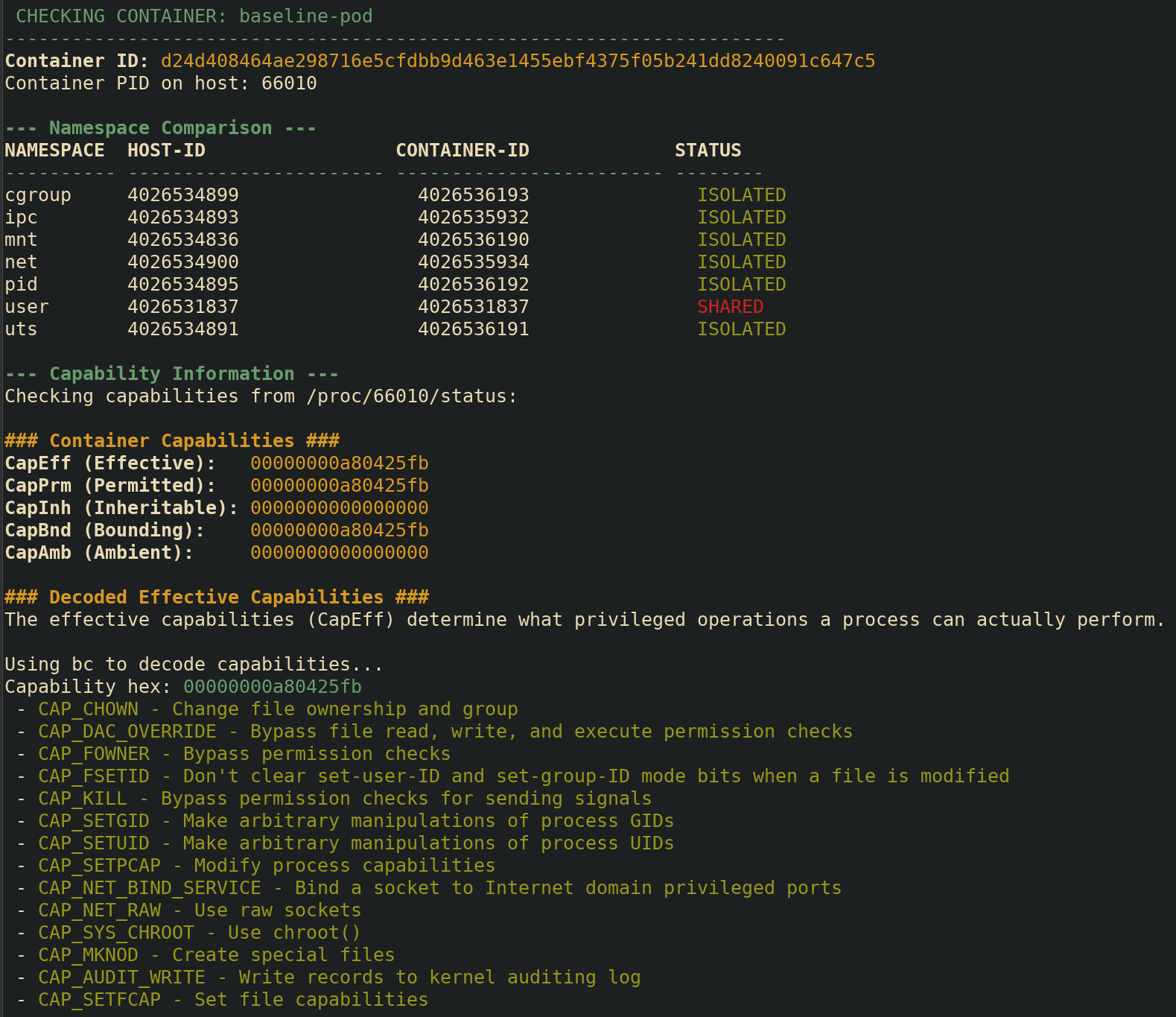
Interestingly, every other pod (with the exception of the privileged
pod, which we will touch on in a moment), has the same capabilities
defined, demonstrating that setting hostNetwork: true,
hostPID: true, and hostIPC: true, do NOT grant
additional capabilities to the pod and instead their “enhanced
privileges” are actually due to the sharing of namespaces observed
previously.
The following summary shows this well. The privileged pod is the only one with sensitive capabilities across the board.

Taking a deeper look at the pod with hostNetwork: true
and we can see that net and uts namespaces are
shared, but there are no other linux capabilities that are providing
additional privileges
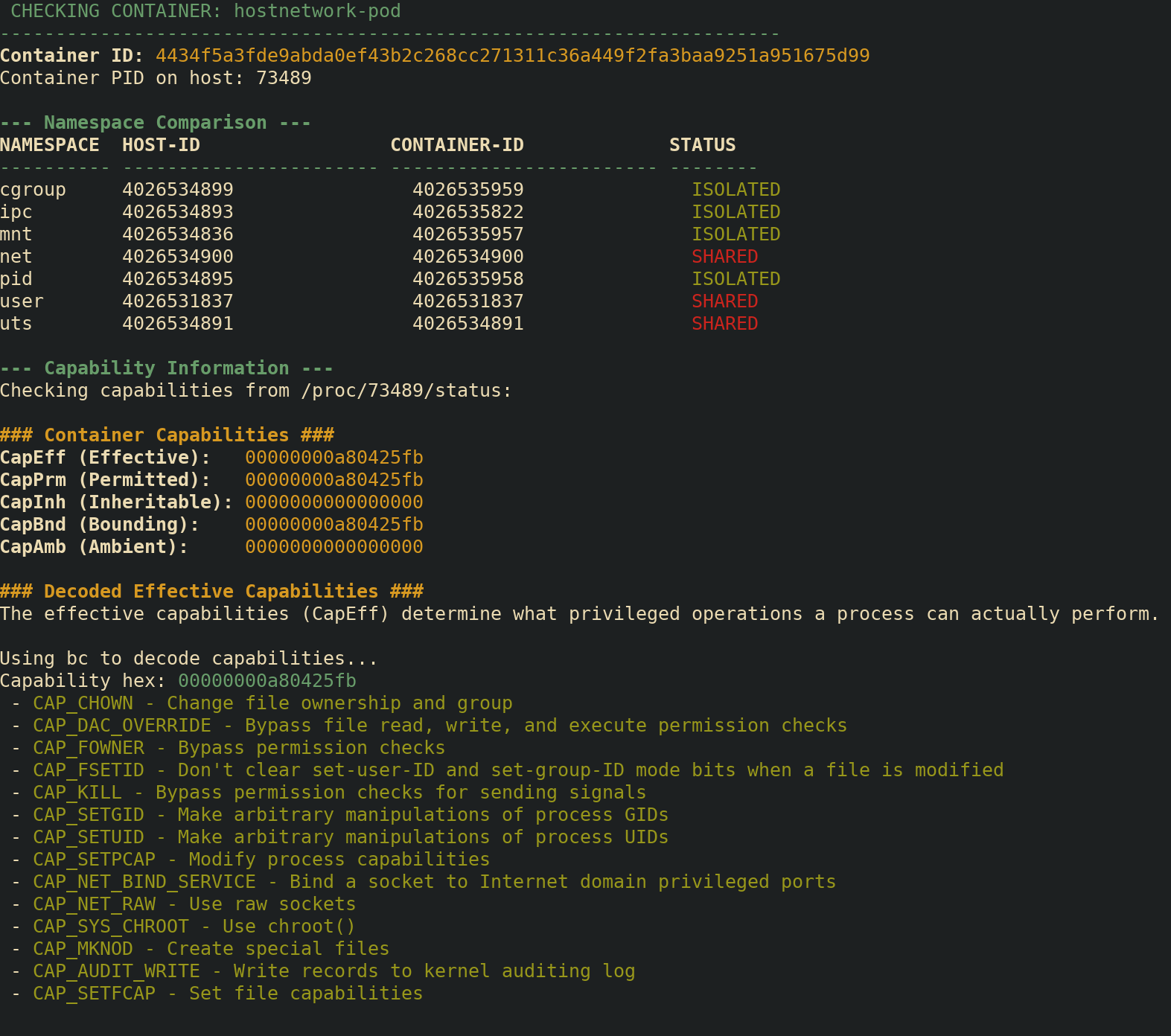
That brings us to our privileged pod. This pod, has essentially every capability assigned to it

The privileged Pod’s capabilities explain why it’s considered dangerous from a security perspective. While namespace sharing provides specific access to host resources, the privileged flag grants broad system-level permissions. This allows the Pod’s container to perform scary operations like loading kernel modules, manipulating network devices, or bypassing file permission checks.
We can easily creating a script to demonstrate these risks. Pay
special attention to demonstration #4 which shows that this pod explicit
cannot (directly) access the hosts pid namespace as we did
not specify the hostPID: true field.
#!/bin/bash
# Set colors for better readability
RED='\033[0;31m'
GREEN='\033[0;32m'
YELLOW='\033[0;33m'
NC='\033[0m' # No Color
echo -e "${YELLOW}Creating a YAML file for a privileged pod...${NC}"
# Create a YAML file for the privileged pod
cat > privileged-pod.yaml << 'EOL'
apiVersion: v1
kind: Pod
metadata:
name: privileged-pod
spec:
containers:
- name: sleep-container
image: busybox:latest
command: ["sleep", "3600"]
securityContext:
privileged: true
restartPolicy: Never
EOL
echo -e "${GREEN}YAML file created. Creating the privileged pod...${NC}"
kubectl apply -f privileged-pod.yaml
echo -e "${YELLOW}Waiting for pod to be ready...${NC}"
kubectl wait --for=condition=Ready pod/privileged-pod --timeout=60s 2>/dev/null || sleep 15
echo -e "${GREEN}Pod is running. Now we'll demonstrate the risks.${NC}"
# Demonstration 1: Direct device access
echo -e "\n${YELLOW}RISK DEMONSTRATION 1: Direct device access${NC}"
echo -e "Command: kubectl exec privileged-pod -- ls -la /dev/"
kubectl exec privileged-pod -- ls -la /dev/ | head -20
# Demonstration 2: Access to host cgroups and proc
echo -e "\n${YELLOW}RISK DEMONSTRATION 2: Host system access${NC}"
echo -e "Command: kubectl exec privileged-pod -- cat /etc/passwd"
kubectl exec privileged-pod -- cat /etc/passwd
# Demonstration 3: Creating a device node (mknod)
echo -e "\n${YELLOW}RISK DEMONSTRATION 3: Creating device nodes${NC}"
echo -e "Command: kubectl exec privileged-pod -- mknod /dev/malicious-device c 1 1"
kubectl exec privileged-pod -- mknod /dev/malicious-device c 1 1
echo -e "Command: kubectl exec privileged-pod -- ls -la /dev/malicious-device"
kubectl exec privileged-pod -- ls -la /dev/malicious-device
# Demonstration 4: Try to access host PID namespace (will show limitation)
echo -e "\n${YELLOW}RISK DEMONSTRATION 4: No access to host PID namespace by default${NC}"
echo -e "Command: kubectl exec privileged-pod -- ps aux"
kubectl exec privileged-pod -- ps aux
echo -e "\n${YELLOW}Notice: The privileged pod only shows container processes, not host processes.${NC}"
echo -e "${YELLOW}To access host PID namespace, you need to explicitly set hostPID: true in the pod spec.${NC}"
# Demonstration 5: Mounting host filesystem
echo -e "\n${YELLOW}RISK DEMONSTRATION 5: Mounting host filesystem${NC}"
echo -e "Command: kubectl exec privileged-pod -- mkdir -p /mnt/host"
kubectl exec privileged-pod -- mkdir -p /mnt/host
echo -e "Command: kubectl exec privileged-pod -- mount -t proc none /mnt/host"
kubectl exec privileged-pod -- mount -t proc none /mnt/host
echo -e "Command: kubectl exec privileged-pod -- ls -la /mnt/host"
kubectl exec privileged-pod -- ls -la /mnt/host | head -10
echo -e "\n${YELLOW}Cleaning up...${NC}"
kubectl delete pod privileged-pod
rm privileged-pod.yaml
echo -e "${GREEN}Demonstration completed.${NC}"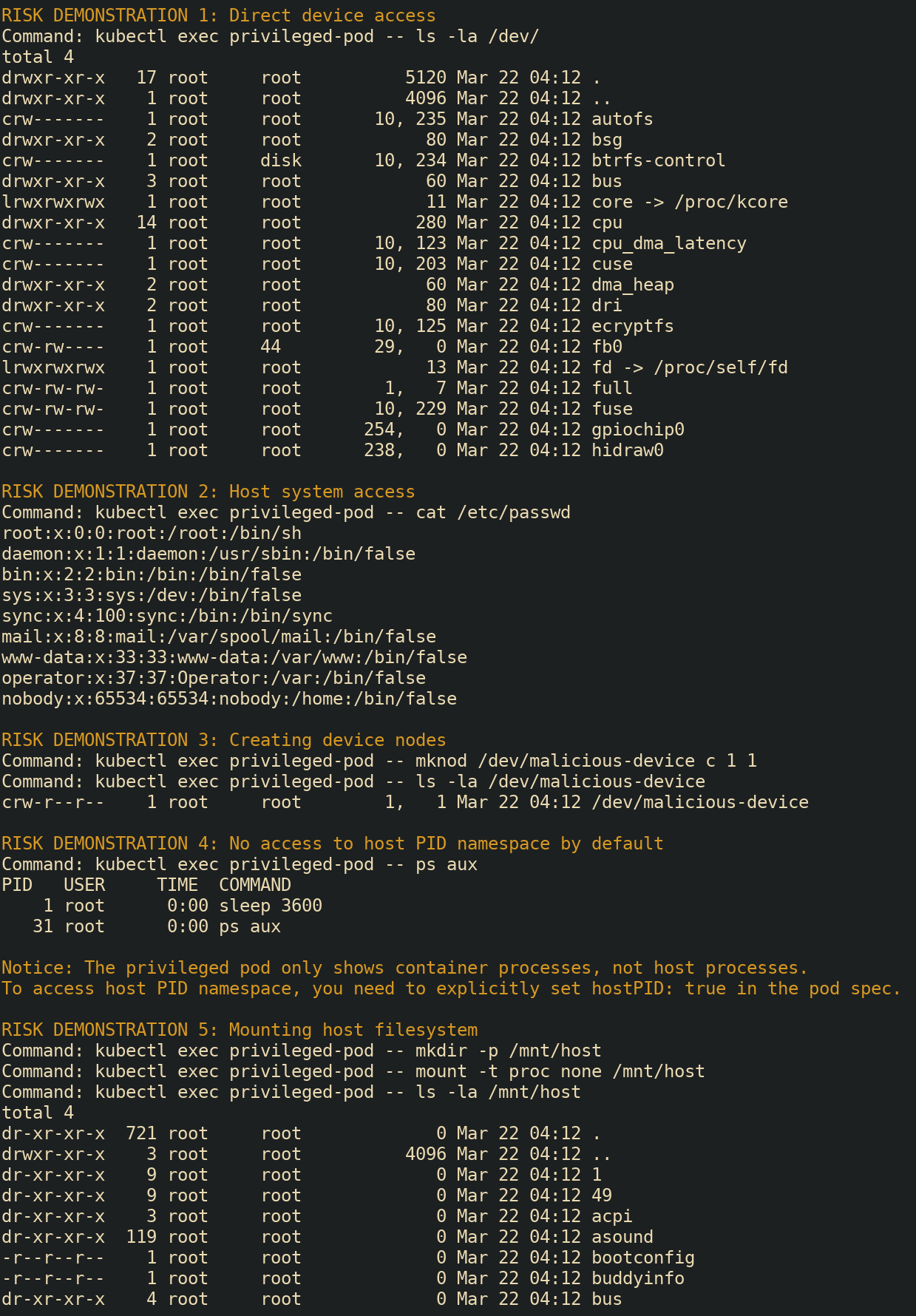
Extra Resources
- The list capabilities a privileged pod has that a non-privileged pod does NOT have.
- CAP_DAC_READ_SEARCH - Bypass file read permission checks
- CAP_LINUX_IMMUTABLE - Set the FS_APPEND_FL and FS_IMMUTABLE_FL flags
- CAP_NET_BROADCAST - Make socket broadcasts and listen to multicasts
- CAP_NET_ADMIN - Perform network administration tasks
- CAP_IPC_LOCK - Lock memory
- CAP_IPC_OWNER - Bypass permissions on message queues and shared memory
- CAP_SYS_MODULE - Load and unload kernel modules
- CAP_SYS_RAWIO - Perform I/O port operations
- CAP_SYS_PTRACE - Trace arbitrary processes
- CAP_SYS_PACCT - Configure process accounting
- CAP_SYS_ADMIN - Perform various system administration operations
- CAP_SYS_BOOT - Use reboot() and kexec_load()
- CAP_SYS_NICE - Raise process nice value and change nice value for arbitrary processes
- CAP_SYS_RESOURCE - Override resource limits
- CAP_SYS_TIME - Set system clock
- CAP_SYS_TTY_CONFIG - Configure TTY devices
- CAP_LEASE - Establish leases on files
- CAP_AUDIT_CONTROL - Configure audit subsystem
- CAP_MAC_OVERRIDE - Override MAC restrictions
- CAP_MAC_ADMIN - Configure MAC
- CAP_SYSLOG - Perform privileged syslog operations
- CAP_WAKE_ALARM - Trigger wake alarms
- CAP_BLOCK_SUSPEND - Block system suspend
- CAP_AUDIT_READ - Read audit logLab environment
minikube config view && minikube profile list && kubectl get all --all-namespaces